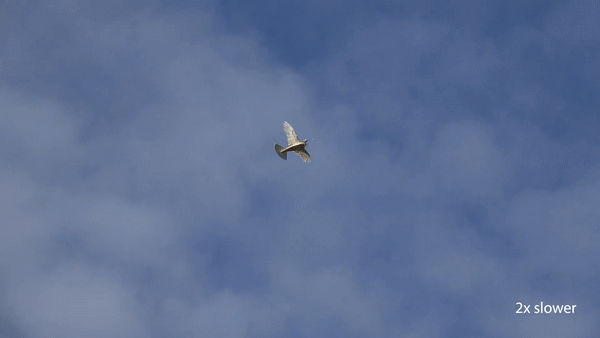This weird-looking pigeon is actually a drone that flies with real feathers

Bird brains: Roboticists have been turning to birds for flight inspiration for years, but they haven’t yet successfully managed to get a drone to fly like one. David Lentink and colleagues at Stanford have come a step closer by creating the first flying robot with soft, feathered wings. It’s able to maneuver more easily and withstand stronger wind speeds than rigid drones, says Lentink. Details of the bird drone were described in two separate papers in Science Robotics and Science today.
Catch that pigeon: To understand how birds control their flight, the researchers studied the skeletons and feathers of common pigeons, which are particularly good at flying in turbulent conditions. They found that pigeons control flight through about 40 Velcro-like feathers, using four “wrist” and “finger” joints to steer their movements. The researchers re-created the same mechanics in a propeller-driven drone. The “body” of the drone is a foam board frame with an embedded GPS and remote-control receiver, while the maneuverable wings have real pigeon feathers attached. The feathered wings were far lighter and more robust than earlier prototypes made using carbon and glass fiber.
It looks a bit... erm rubbish: Well, yes, fair enough. The “PigeonBot” is only an early prototype, but it could pave the way for drones that maneuver as nimbly as birds. Giving drones bird-like wings could make them lighter and thus more efficient, meaning they’d be able to travel longer distances without having to refuel. It could also make them easier to control, especially in windy conditions.
Deep Dive
Artificial intelligence
Large language models can do jaw-dropping things. But nobody knows exactly why.
And that's a problem. Figuring it out is one of the biggest scientific puzzles of our time and a crucial step towards controlling more powerful future models.
Google DeepMind’s new generative model makes Super Mario–like games from scratch
Genie learns how to control games by watching hours and hours of video. It could help train next-gen robots too.
What’s next for generative video
OpenAI's Sora has raised the bar for AI moviemaking. Here are four things to bear in mind as we wrap our heads around what's coming.
Stay connected
Get the latest updates from
MIT Technology Review
Discover special offers, top stories, upcoming events, and more.